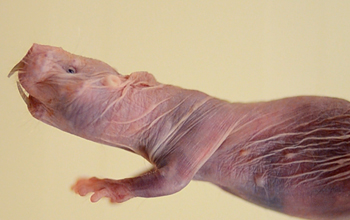Multimedia Gallery
African Naked Mole Rat
A close-up view of an African naked mole rat.
Research by Thomas Park, a professor of biological sciences at the University of Illinois at Chicago (UIC), and supported by the National Science Foundation (grant IOS 07-44979) found that naked mole rats evolved so they could survive in an acidic environment that would not be tolerable by other mammals, including humans.
Carbon dioxide builds up to toxic levels in the tight and crowded burrows that mole rats call home, and the air becomes highly acidic. Park says the mole rat's tolerance to their toxic environment could offer clues to relieving pain in humans and other animals. For example, the lingering pain of an injury is caused by acidification of the injured tissue. Park says that studying an animal that feels no pain from an acidified environment could lead to new ways of alleviating pain in humans.
To learn more, see the UIC news story Naked Mole-rats May Hold Clues to Pain Relief. (Date of Image: May 2012)
Credit: Joshua Clark, UIC Photo
See other images like this on your iPhone or iPad download NSF Science Zone on the Apple App Store.
Images and other media in the National Science Foundation Multimedia Gallery are available for use in print and electronic material by NSF employees, members of the media, university staff, teachers and the general public. All media in the gallery are intended for personal, educational and nonprofit/non-commercial use only.
Images credited to the National Science Foundation, a federal agency, are in the public domain. The images were created by employees of the United States Government as part of their official duties or prepared by contractors as "works for hire" for NSF. You may freely use NSF-credited images and, at your discretion, credit NSF with a "Courtesy: National Science Foundation" notation.
Additional information about general usage can be found in Conditions.
Also Available:
Download the high-resolution JPG version of the image. (1.1 MB)
Use your mouse to right-click (Mac users may need to Ctrl-click) the link above and choose the option that will save the file or target to your computer.

